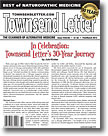|
![]()
From the Townsend Letter |
||
Small Intestine Bacterial Overgrowth: Often-Ignored Cause of Irritable Bowel Syndrome by Allison Siebecker, ND, MSOM, LAc, and Steven Sandberg-Lewis, ND, DHANP |
||
Diet Supplements Probiotics are a controversial intervention in SIBO because lactobacilli have been cultured in SIBO and there is concern about adding to the bacterial overload, particularly in this situation of dysfunctional MMC.25 Despite this, the few studies that have focused directly on SIBO have shown good results, with a SIBO eradication rate of 47% from Bacillus clausii as the only treatment, and a clinical improvement rate of 82% from Lactobacillus casei and plantarum, Streptococcus faecalis, and Bifidobacter brevis (Bioflora) as the only treatment.63,64 Probiotic yogurt containing Lactobacillus johnsonii normalized cytokine responses – reducing the low-grade chronic inflammation found in SIBO, after 4 weeks.65 We have used various multistrain and single probiotics as well as yogurt and cultured vegetables in our SIBO patients, with good results. A key point for the use of probiotic supplements in SIBO is to avoid prebiotics as main ingredients. Prebiotics are fermentable food for bacteria that can exacerbate symptoms during active SIBO and encourage bacterial growth post SIBO. Common prebiotics found in probiotic supplements include FOS (fructooligosaccharide), inulin, arabinogalactan, and GOS (galactoligosaccharide). Prebiotics may be tolerated in small amounts used as base ingredients, but this depends on the individual. Brush border healing supplements may be given to assist the repair of small intestine tissue. While mucilaginous herbs are traditionally employed for this purpose (licorice, slippery elm, aloe vera, marshmallow), their use is controversial post SIBO, due to their high level of mucopolysaccharides, which could encourage bacterial regrowth. Specific nutrients that we have used include colostrum: 2–6 g q.d., L-glutamine: 375 mg–1500 mg q.d., zinc carnosine: 75–150 mg q.d., vitamins A and D, often given as cod liver oil: 1 Tbs q.d., curcumin: 400 mg–3 g q.d., resveratrol: 250 mg–2 g q.d., glutathione (oral liposomal): 50–425 mg q.d. or glutathione precursor N-acetylcysteine 200–600 mg q.d. Supplements are given for one to three months, though may be continued long term for general benefit. Higher dosages of curcumin and resveratrol are given for two weeks for the purpose of downregulating NF-kb, a mediator of increased intestinal permeability, and then reduced to maintenance levels. 66–68 In our practices we have found that the following circumstances increase the chances for an unsatisfactory patient outcome:
|
||
![]()
Consult your doctor before using any of the treatments found within this site.
![]()
Subscriptions are available for Townsend Letter, the Examiner of Alternative Medicine magazine, which is published 10 times each year.
Search our pre-2001 archives for further information. Older issues of the printed magazine are also indexed for your convenience. 1983-2001 indices ; recent indices
Once you find the magazines you'd like to order, please use our convenient form, e-mail subscriptions@townsendletter.com, or call 360.385.6021 (PST).
360.385.6021
Fax: 360.385.0699
info@townsendletter.com
Who are
we? | New articles | Featured
topics | e-Edition |
Tables of contents | Subscriptions | Contact
us | Links | Classifieds | Advertise |
Alternative
Medicine Conference Calendar | Search site | Archives |
EDTA Chelation Therapy | Home
© 1983-2013 Townsend Letter
All rights reserved.
Website by Sandy
Hershelman Designs




